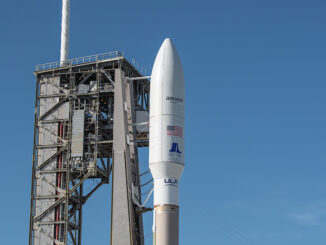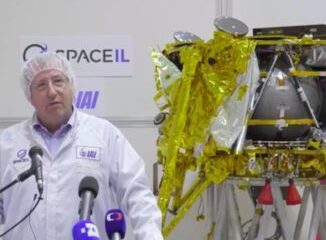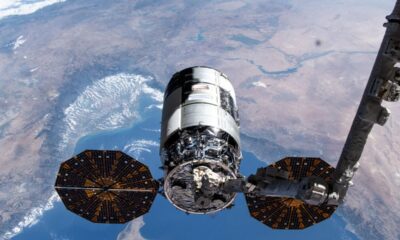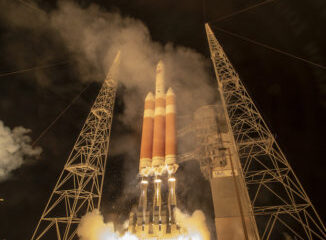Science
ULA Launches Vulcan Rocket on Historic Space Force Mission

On August 12, 2025, United Launch Alliance (ULA) successfully launched its first fully operational Vulcan rocket from Space Launch Complex 41, marking a significant milestone in U.S. military aerospace capabilities. The mission, designated USSF-106, was the inaugural national security launch utilizing the Vulcan, and it represented ULA’s 101st national security mission overall.
The Vulcan rocket, measuring 198 feet tall and equipped with four solid-fuel strap-on boosters, lifted off at 20:56 EDT. As the rocket ascended from Cape Canaveral Space Force Station, its two methane-fueled BE-4 engines generated nearly 3 million pounds of thrust, creating a brilliant display visible for miles around.
Mission Details and Payload
Approximately 90 seconds after liftoff, the four strap-on boosters were detached, followed by the separation of the first stage three-and-a-half minutes into the flight. The Centaur second stage ignited its two hydrogen-fueled Aerojet Rocketdyne RL10C engines, continuing the flight under military protocol that necessitated the cessation of launch commentary.
The USSF-106 mission is believed to have transported at least two satellites: one classified spacecraft and an experimental satellite, known as Navigation Technology Satellite 3 (NTS-3). This satellite is designed to test advanced atomic clock technology and navigation systems, aiming to enhance the accuracy and reliability of military and commercial GPS data. NTS-3 is notable as the Pentagon’s first experimental navigation satellite since the early GPS prototypes launched in the 1970s.
Joanna Hinks, a senior aerospace engineer at the Air Force Research Laboratory, emphasized the importance of GPS in daily life. “We are going to be experimenting with a number of different technologies that look at how we can continue to evolve and augment GPS,” she stated, highlighting the satellite’s role in ensuring that GPS remains a vital tool for military operations.
A Landmark for United Launch Alliance
The launch of the Vulcan rocket signifies a crucial development for ULA, following two test flights completed the previous year. This mission is officially certified by the Space Force, allowing ULA to transport high-value military payloads into secure orbits.
Gary Wentz, ULA’s Vice President of Government and Commercial Programs, noted the mission’s significance: “This mission is headed directly to geosynchronous orbit and will be one of our longest missions to date.” He added that the Vulcan is specifically designed to support missions that require direct injection into geosynchronous orbit, underscoring its advanced capabilities.
The Vulcan rocket is set to replace ULA’s retired Delta family and the Atlas 5, which has relied on a Russian-built RD-180 engine. The transition to an all-American launcher comes amid congressional pressure concerning the reliance on foreign technology for military launches.
As of now, ULA has 13 Atlas 5 rockets remaining in its inventory, which are designated for civilian missions. Meanwhile, SpaceX continues to dominate the commercial launch market with its Falcon 9 and Falcon Heavy rockets. ULA’s President and CEO, Tory Bruno, expressed confidence in the Vulcan’s capabilities, stating that its high-performance BE-4 engines, developed by Blue Origin, make it particularly suited for launching heavy military payloads into challenging orbits.
Bruno explained that the Vulcan’s design allows for efficient launches without the need for satellites to utilize their own thrusters for orbital adjustments, providing enhanced performance and cost savings compared to traditional multi-core launch vehicles.
Looking ahead, ULA plans to expand its ground infrastructure and anticipates launching up to nine flights in 2025, aiming for a cadence of two launches per month by the year’s end. The company expects to conduct between 20 and 25 flights in 2026, solidifying its position in the evolving landscape of aerospace launch services.
-

 Technology5 months ago
Technology5 months agoDiscover the Top 10 Calorie Counting Apps of 2025
-

 Technology2 weeks ago
Technology2 weeks agoOpenAI to Implement Age Verification for ChatGPT by December 2025
-

 Health3 months ago
Health3 months agoBella Hadid Shares Health Update After Treatment for Lyme Disease
-

 Health3 months ago
Health3 months agoErin Bates Shares Recovery Update Following Sepsis Complications
-

 Health3 months ago
Health3 months agoAnalysts Project Stronger Growth for Apple’s iPhone 17 Lineup
-

 Technology5 months ago
Technology5 months agoDiscover How to Reverse Image Search Using ChatGPT Effortlessly
-

 Technology3 months ago
Technology3 months agoElectric Moto Influencer Surronster Arrested in Tijuana
-

 Technology2 months ago
Technology2 months agoDiscover 2025’s Top GPUs for Exceptional 4K Gaming Performance
-

 Technology5 months ago
Technology5 months agoMeta Initiates $60B AI Data Center Expansion, Starting in Ohio
-

 Technology5 months ago
Technology5 months agoRecovering a Suspended TikTok Account: A Step-by-Step Guide
-

 Health5 months ago
Health5 months agoTested: Rab Firewall Mountain Jacket Survives Harsh Conditions
-

 Lifestyle5 months ago
Lifestyle5 months agoBelton Family Reunites After Daughter Survives Hill Country Floods



















